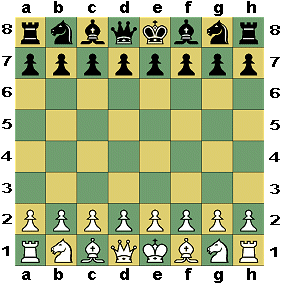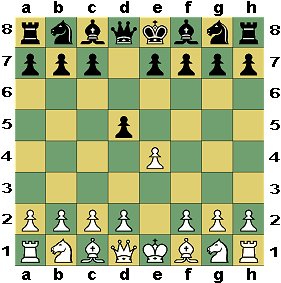How can you record your own chess games for later study (or to show your greatness to future generations)? The answer is in chess notation. This article (part 1 of 3 parts) will show you how to use algebraic notation to record your chess games and read the games of others.
Algebraic notation
I learned chess using English descriptive notation. I prefer it for sentimental reasons. A lot of the books in my library are printed with descriptive notation. But the modern chess world has abandoned descriptive notation for algebraic. Algebraic notation does have its advantages, and – best of all – it is easy to explain. 🙂 So we’ll learn algebraic notation.
Each square has a name
First, each square of the chess board has a name. Each square is designated by a letter corresponding to the vertical columns (called “files”) and a number corresponding to the horizontal rows (called “ranks”). The dark square at White’s lower left is called “a1,” and the squares across White’s first rank (where White’s King, Queen, and other pieces are lined up in the starting position) are called a1, b1, c1, d1, e1, f1, g1, and h1. The second row (where White’s Pawns are lined up in the starting position) are called a2, b2, c2, … h2. The rest of the squares of the chess board are similarly labeled until we get to Black’s king-side Rook, which sits on h8 in the starting position.
The diagram of the chessboard below has letters along the right and left side of the chess board and numbers along the top and bottom of the chess board.

For any square, you can find the letter designation by looking along the top or bottom and the proper number by looking at the numbers along the sides. For example, the White Pawn in the diagram below has been moved to e4 and the Black Pawn has been moved to d5.

By the way … always use lower-case letters for designating the squares. The reason for this is that the pieces are designated using upper-case letters.
How the pieces are named
The pieces are labeled as follows:
- Rook = R
- Knight = N
- Bishop = B
- Queen = Q
- King = K
To record a move, you first write the piece that is moving and then put the name of the square that the piece is moving to. So if the King is moving to f1, you write “Kf1.” If the Rook is moving to e5, you write “Re5.”
Recording Pawn Moves
The Pawn is not normally given a label. For Pawn moves, only the destination square is named. So if White moves the Pawn in front of his King two squares forward on his first move, the notation to record that move is just “e4.”
In part 2, we will cover recording captures, castling, and checkmate. In part 3, we’ll review the chess notation of an entire game.
You can learn all the rules … including chess notation in the wonderful book that I recommend to new players: Learn Chess: A Complete Course. And be sure to see my other posts for the absolute chess beginner.

What if two pieces can both move onto the same square, such as say, two White Rooks that can both move onto c5? How is that notated so it’s clear early on, which Rook was moved please?
Thanks my name is Bruce 68 years old this going to be very helpful to learn the way it should be texting back and forth .
I’ll be playing my friend by texting back and forth this will be very helpful thanks.
I`m glad to have stumbled upon this site. I’ve played a couple of games w a friend-trying to learn. You are finally setting me straight on how to actually get started so that I might actually WIN. :>)
THANK YOU. I just stared to learn chess